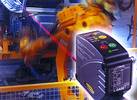

The L-GAGE LT3 time-of-flight sensor is a self-contained, Class 2 laser distance-gauging device that can precisely measure the distance to an object at long ranges up to 50 m.
Utilising 'time-of-flight' technology, Banner Engineering's LT3 times the travel of its laser beam from the sensor to the target and back to the sensor. It pulses one million times per second, and its microprocessor averages 1000 pulses every 0,001 second to provide precise measurement data. The microprocessor-controlled sensor's unique design and exceptional range offer flexibility for a variety of applications, including determining position of automated storage/retrieval cars, positioning fixtures, measuring levels in bins, measuring distance to objects and heights of objects on conveyors, measuring diameters of logs, protecting overhead cranes from collision, measuring roll diameters, controlling loop tension and long-distance sensing of parts in fixtures.
The LT3 sensor provides sensing ranges of 0,3 to 3 m for grey targets; 0,3 to 5 m for white targets. A retroreflective model is available for applications that require more sensing range, up to 50 m. The device has a measurement resolution of 1 mm depending on response speed. The LT3 features a modulated visible red sensing beam, and both a discrete (switched) output, and an analog output, or both simultaneously, with independently programmed window limits. A patented scalable analog output distributes the analog signal evenly over the width of the programmed sensing window to optimise sensing performance.
Pushbutton programming simplifies the configuration. In TEACH mode, with a single pushbutton, users can program a unique sensing window size and position, or a unique setpoint threshold centred within a 1 m window. Output response speed is programmable to 1, 10 or 100 ms. The LT3 analog output provides a variable signal (4 to 20 mA to 0 to 10 V d.c., depending on model) that is proportional to the target's position within the user-programmed analog window limits. The discrete (switched) output energises whenever the target is located between the user-programmed discrete window limits. Window limits for the analog and discrete outputs may be the same, or they may be programmed independently.
The analog output slope can be positive or negative, depending on which window limit is programmed first. The LT3 can be programmed from a remote location for added security, and it includes a remote lockout feature that prevents tampering.
The unit conserves production space and decreases set-up time by eliminating the need for a separate controller. The compact self-contained device measures 68,5 mm high, by 35,3 mm wide, by 86,2 mm deep, allowing it to fit and function in small spaces.
The new sensor features an advanced diagnostic indication system that keeps users informed of operating status. A green Power On LED indicates 'Power on' and 'Output overloaded' and 'Disabled laser'. A yellow Output LED indicates when the discrete load output is conducting. The red Signal LED indicates when the target is in the sensing window and the condition of the received light signal.
A yellow Speed LED indicates the response speed setting. The Red/Green 'Teach' LEDs indicate sensor readiness for programming each limit (analog, discrete, or simultaneous analog and discrete).
Output configurations for the 12 to 24 V d.c. LT3 include a solid-state switch with a choice of NPN (sinking) or PNP (sourcing) discrete outputs, plus a 4-20 mA (current sourcing), or a 0-10 V d.c. (voltage sourcing) analog output. Internal circuitry protects the LT3 from reverse polarity and transient voltages. The sensor features a durable housing moulded from ABS/polycarbonate blend with an acrylic lens. It is rated IP67 and has an operating temperature range of -10°C to +50°C. It is available with a 2 m or a 9 m, 7-conductor shielded, PVC-jacketed attached cable; or an 8-pin Euro-style swivel quick-disconnect fitting.
| Tel: | +27 11 453 2468 |
| Email: | [email protected] |
| www: | www.turckbanner.co.za |
| Articles: | More information and articles about Turck Banner Southern Africa |

© Technews Publishing (Pty) Ltd | All Rights Reserved